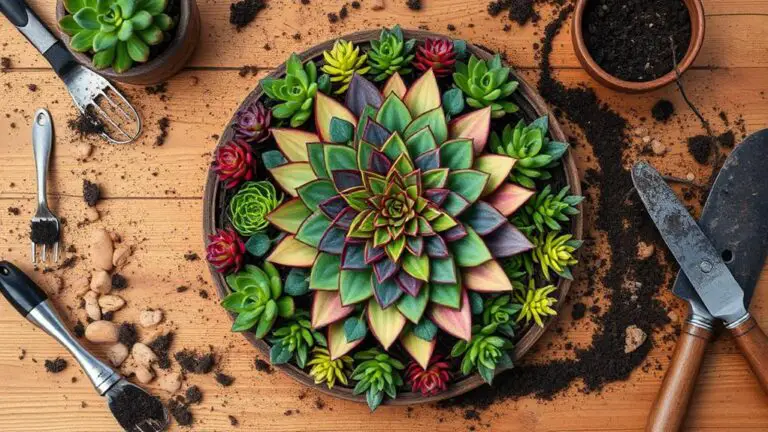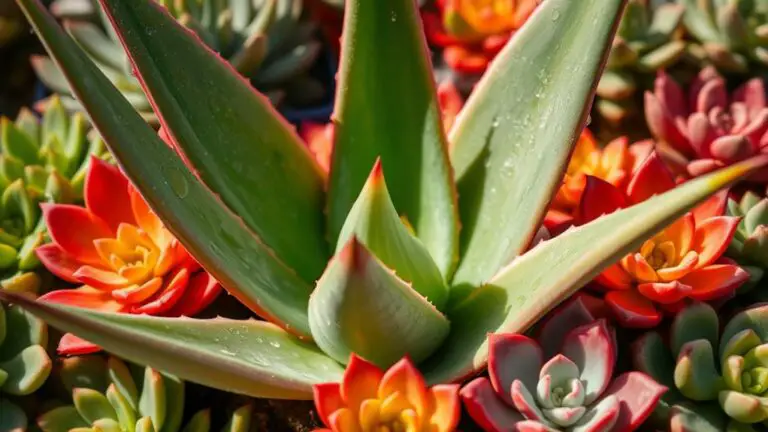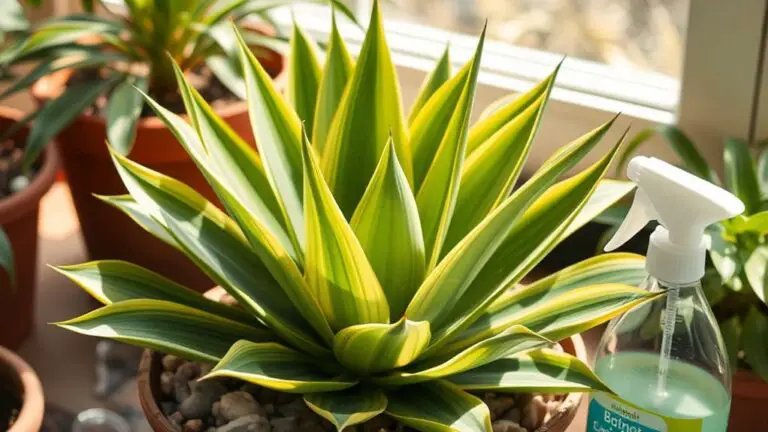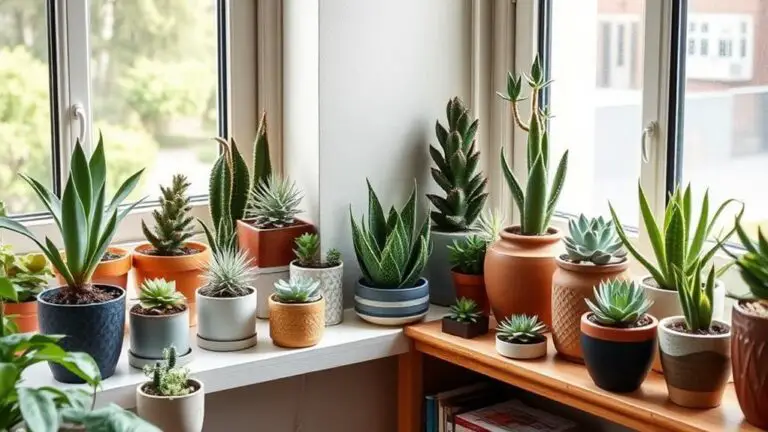How to Choose the Right Grow Light: Do You Need One?
When thinking about whether you need a grow light, start by evaluating your indoor gardening goals and the specific needs of your plants. Consider the natural light in your space; if it's lacking, a grow light might be essential for healthy growth. You'll need to choose between LED, fluorescent, or incandescent lights based on their energy efficiency, lifespan, and suitability for your plants' light spectrum needs. Full-spectrum lights are often recommended for balanced wavelengths throughout all plant life stages. But how do you determine the best fit for your setup? Let's explore the factors that will guide your decision.
Importance of Grow Lights

When it comes to indoor gardening, grow lights are indispensable. They act as substitutes for natural sunlight, which is essential for plants to perform photosynthesis and stay healthy. In low-light environments, these light systems are essential for maintaining your plants' growth and wellbeing.
You'll find that grow lights are particularly beneficial because they let you garden all year round. Regardless of the season, you can keep your plants thriving by providing the consistent light they require. This is especially important for indoor gardening, where natural sunlight mightn't be sufficient.
Using quality full-spectrum lights guarantees your plants get the complete range of light wavelengths they need. Blue light helps with chlorophyll production, while red light encourages flowering. This combination promotes even growth, making full-spectrum grow lights a must-have for peak growth.
Proper light distribution is also critical. Grow lights should cover all your plants evenly, making sure even the seedlings on the perimeter get enough light.
Most plants require about 16-18 hours of light daily, so setting up an efficient light system is key.
With the right grow lights, you're setting your indoor garden up for success. Happy gardening!
Grow Bulbs vs. Grow Lights
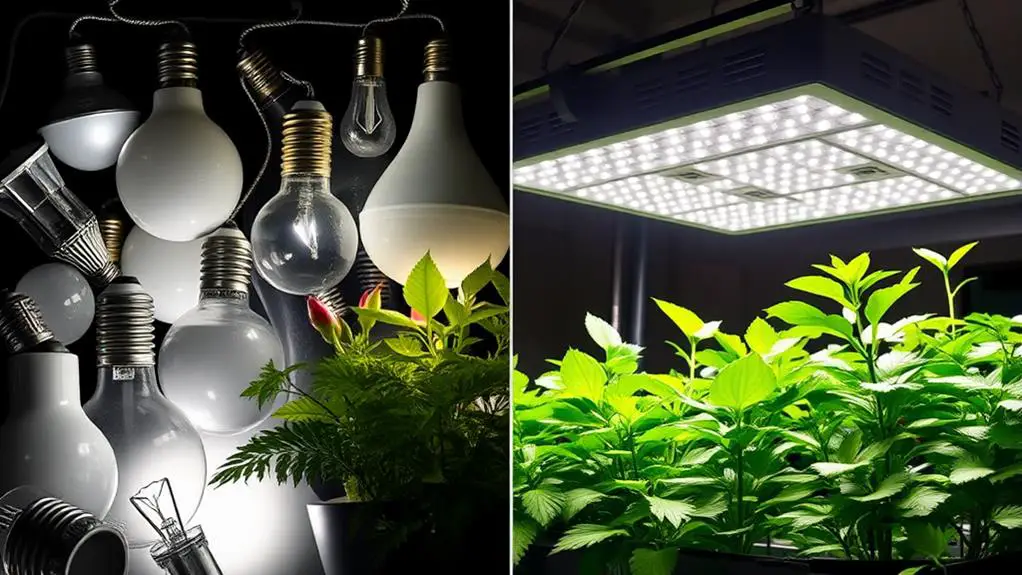
Choosing between grow bulbs and dedicated grow lights can greatly impact your indoor gardening success.
Grow bulbs are a cost-effective option that fit into existing fixtures, but they often provide uneven lighting and a limited light spectrum. This means that while they can be a good short-term solution, they may not support the full range of light needed for successful plant growth over time.
On the other hand, dedicated grow lights are specifically designed for plant growth. They offer ideal light coverage and the flexibility to adjust placement for better light distribution.
LED options in particular can be tailored for specific plant needs, providing full spectrum or targeted color outputs that promote healthier growth and flowering.
Investing in dedicated grow lights is often more beneficial in the long run. They enhance plant health and growth efficiency, unlike grow bulbs which may lead to less than ideal results.
With dedicated grow lights, you can guarantee your plants receive the necessary light spectrum for each stage of their growth, from seedlings to flowering.
Types of Grow Lights
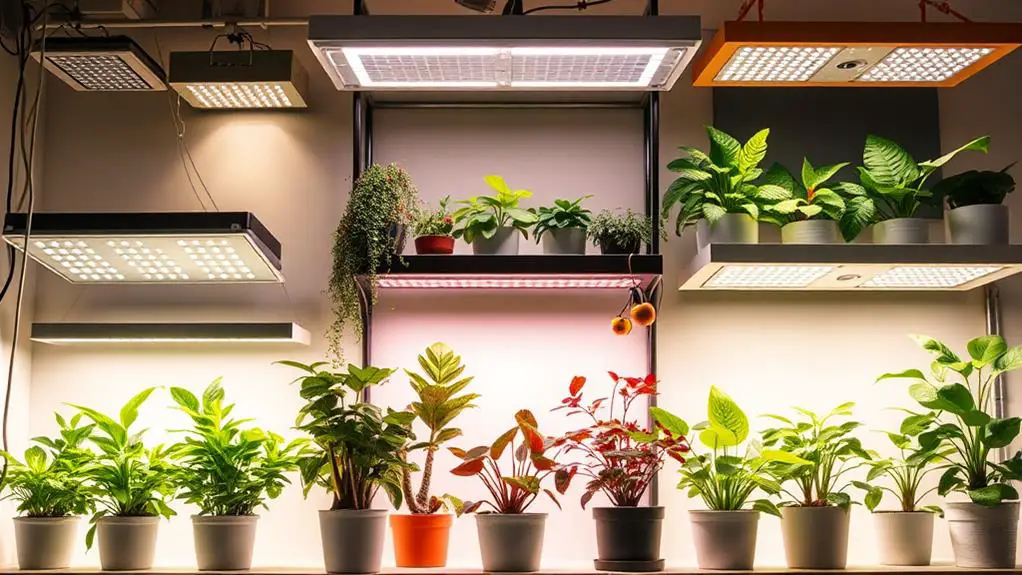
Let's look at the types of grow lights you can choose from.
LED lights are a great option because they're energy-efficient, last a long time, and can be adjusted for different stages of plant growth.
Fluorescent lights, especially T5 tubes, are perfect for starting seeds, while incandescent lights aren't recommended due to their high heat and limited spectrum.
Incandescent Light Characteristics
As you explore the world of grow lights, it's important to understand the characteristics of incandescent options. Incandescent lights are often the cheapest choice, but they're not very energy efficient. They consume more electricity while providing less light output than other types. For indoor plants, this means higher electricity bills without the best light coverage.
These lights also emit a high amount of heat, which can be harmful if placed too close to your plants. To avoid damage, keep them at least 24 inches above your plants. Additionally, incandescent bulbs have a limited light spectrum, mostly in the red and yellow regions. This makes them less effective for meeting all your plant needs, especially when compared to full-spectrum alternatives.
Here's a quick comparison to help you understand better:
| Characteristic | Incandescent Lights | Impact on Plants |
|---|---|---|
| Energy Efficiency | Low | High electricity usage |
| Heat Output | High | Potential plant damage |
| Light Spectrum | Red and Yellow | Limited growth and flowering |
| Lifespan | Around 1,000 hours | Frequent replacements needed |
Considering these factors, incandescent lights might not be the best choice for serious indoor gardening. They can be more trouble than they're worth, given their inefficiency and frequent need for replacement.
Fluorescent Light Benefits
Fluorescent lights offer several advantages that make them a popular choice for indoor gardening. These lights are energy-efficient and provide a broad spectrum of light, making them perfect for seed starting and growing low- to medium-light plants indoors. With options like T5 and T8 tubes, fluorescent lights can last around 10,000 hours, giving you a cost-effective solution for long-term use.
One of the biggest benefits of fluorescent lights is their low heat emission. Unlike incandescent lights, they can be placed close to your plants without the risk of burning the foliage. This is especially useful for seedlings, as you can position the lights just a few inches above the plants to encourage robust growth and healthy development.
Fluorescent grow lights also have a high Color Rendering Index (CRI), typically above 85. This means they help plants utilize light effectively for photosynthesis, ensuring steady growth.
If you're looking for a reliable and efficient way to support your indoor garden, fluorescent lights are a great option. They balance energy efficiency with effective lighting, making your gardening efforts both productive and economical.
LED Light Advantages
LED grow lights have revolutionized indoor gardening with their unmatched energy efficiency and versatility. If you're looking for an energy-efficient light source, LEDs are your best bet. They consume up to 60% less electricity than traditional lights, saving you money on your energy bill while still giving your plants the light they need.
One of the great things about LEDs is their customizable light spectrum. This means you can adjust the color output to meet the specific needs of your plants at different growth stages. Whether your plants need more red light for blooming or blue light for vegetative growth, LEDs can easily provide it.
LED lights also have a high Color Rendering Index (CRI) above 90, which closely mimics natural sunlight. This is great for promoting healthier plant growth and more accurate colors.
Plus, with a lifespan of 25,000 to 50,000 hours, you won't need to replace them as often as other types of bulbs.
Another advantage is their low heat output. You can place LED lights closer to your plants without worrying about burning the foliage. This makes them ideal for small indoor gardens where space is limited.
Light Spectrum Effects
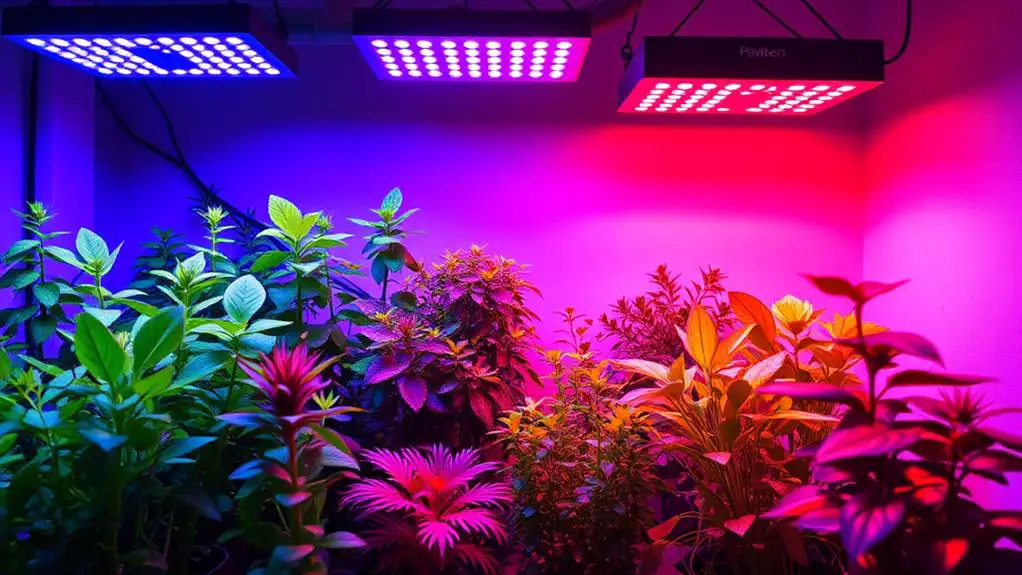
Understanding how different wavelengths of light affect plant growth is essential for choosing the right grow light. The light spectrum effects play an important role in how well your plants develop. For instance, blue light is critical for chlorophyll production and foliage growth, while red light helps your plants to flower. Full-spectrum light combines red and blue wavelengths, promoting overall plant health and growth.
If you want the best results, look for lights that fall within the Photosynthetically Active Radiation (PAR) range of 400 to 700 nanometers. This range is ideal for effective photosynthesis. However, be careful with excessive red light, as it can cause leggy growth.
While green and yellow light have minimal effects on germination, they don't greatly impact overall growth.
When selecting grow lights, consider the Color Rendering Index (CRI). A high CRI above 85 guarantees better light quality, mimicking natural sunlight. This enhances plant growth efficiency.
Full-spectrum lights are generally more beneficial than pink or purple lights due to their broader range. Remember, understanding the ideal light spectrum and its effects can help you create the best environment for your plants.
Placement and Usage
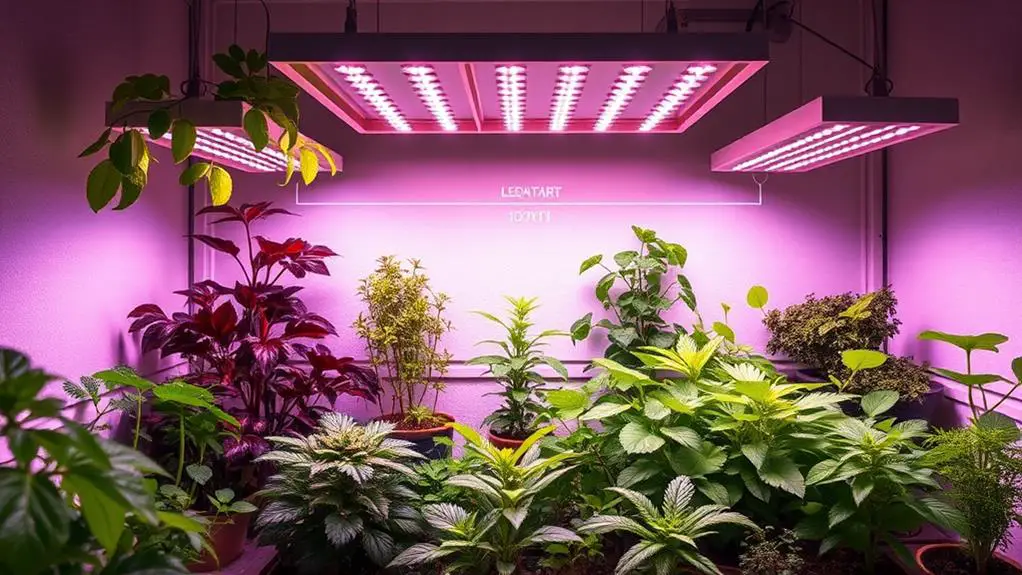
To optimize your indoor plant growth, it's important to position grow lights directly above the plants, simulating natural sunlight and guaranteeing even light distribution.
The placement of your light fixtures is vital. For incandescent lights, keep them at least 24 inches away from your plants. Fluorescent lights should be placed 12 inches away, and LED lights can be as close as 6 inches.
As your plants grow, adjust the height of the lights to avoid leaf burn. Browning leaves mean the lights are too close, while lanky seedlings suggest they're too far. Different types of grow lights have different heat outputs, so monitoring the temperature around your indoor grow setup is significant to prevent damage.
Flowering plants typically need 12-16 hours of light per day, with at least 8 hours of darkness to stay healthy. Confirm you have enough light fixtures to cover your plants evenly.
Multiple bulbs can mimic the sun's natural movement, enhancing light distribution. Remember to use adjustable fixtures to maintain the proper distance as your plants grow.
Light Specifications

When choosing a grow light, understanding color temperature and light quality is essential.
Aim for a Correlated Color Temperature (CCT) near 6500K, which mimics natural daylight and helps plants thrive.
Also, look for a Color Rendering Index (CRI) rating above 85 to guarantee the light supports healthy plant growth.
Understanding Color Temperature
In the domain of grow lights, the concept of Correlated Color Temperature (CCT) is vital to fostering healthy plant growth. CCT, measured in Kelvins (K), helps you understand the color of light your plants receive. For grow lights, aim for around 6500K to simulate natural daylight, which is perfect for most plants.
The light spectrum is essential for plant growth. Blue light is necessary for chlorophyll production, helping your plants grow strong stems and leaves. Red light is important for flowering and fruiting stages. Full spectrum lights, which mimic sunlight, provide both blue and red light, making them an excellent choice for overall plant health.
Another significant factor is the Color Rendering Index (CRI). A good CRI rating for grow lights is above 85. The maximum CRI for natural sunlight is 100, showing how accurately colors are represented under the light. Full spectrum lights usually have a CRI above 90, ensuring your plants get the best light possible.
Choosing the right grow light involves understanding both CCT and light output. Lower wattage LEDs often produce more light than higher wattage fluorescent bulbs, so don't just go by wattage alone.
Consider these factors to make your plants thrive.
Evaluating Light Quality
Evaluating light quality is vital for guaranteeing your plants get the best possible conditions for growth. You'll need to take into account several important factors.
First, the ideal Correlated Color Temperature (CCT) for grow lights is around 6500K. This mimics natural daylight, promoting ideal plant growth.
Next, think about the Color Rendering Index (CRI). A CRI above 85 means the light quality is suitable for accurate color representation and plant health. When your plants receive the right light quality, they can thrive more easily.
Understanding Photosynthetically Active Radiation (PAR) is also important. PAR covers the 400 to 700 nm wavelength range, necessary for photosynthesis. This guarantees your plants get the light they need to grow.
Another significant metric is Photosynthetic Photon Flux Density (PPFD). PPFD quantifies the light available for photosynthesis, helping you assess the effectiveness of your grow lights.
Lastly, think about using high-output LEDs. They often produce more light with lower wattage compared to traditional fluorescent options. This means you can save energy while providing ample light for your plants.
Fixtures and Distance
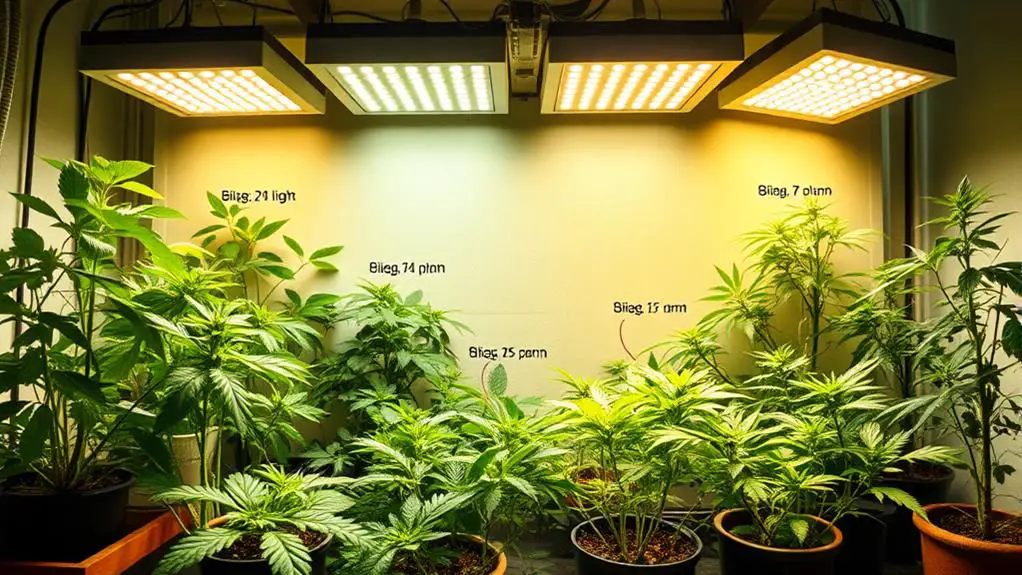
Positioning your grow lights correctly is essential for simulating natural sunlight and ensuring healthy plant development.
Start by placing your fixtures at the right distance from your plants. For LED lights, you can position them as close as 6 inches, but generally, a distance of 30-60 cm is recommended for ideal light exposure.
Using adjustable fixtures is key, as it allows you to modify the height as your plants grow, ensuring they receive even light distribution.
Here are some tips to help you get started:
- Incandescent lights: Place these at least 24 inches above your plants to avoid burning.
- Fluorescent lights: Position these around 12 inches away for the best results.
- LED lights: These can be closer, about 6 inches initially, but adjust as needed to avoid light stress.
- Adjust as needed: Watch for signs like browning leaves (too close) or lanky seedlings (too high) and adjust the distance accordingly.
Costs and Accessories
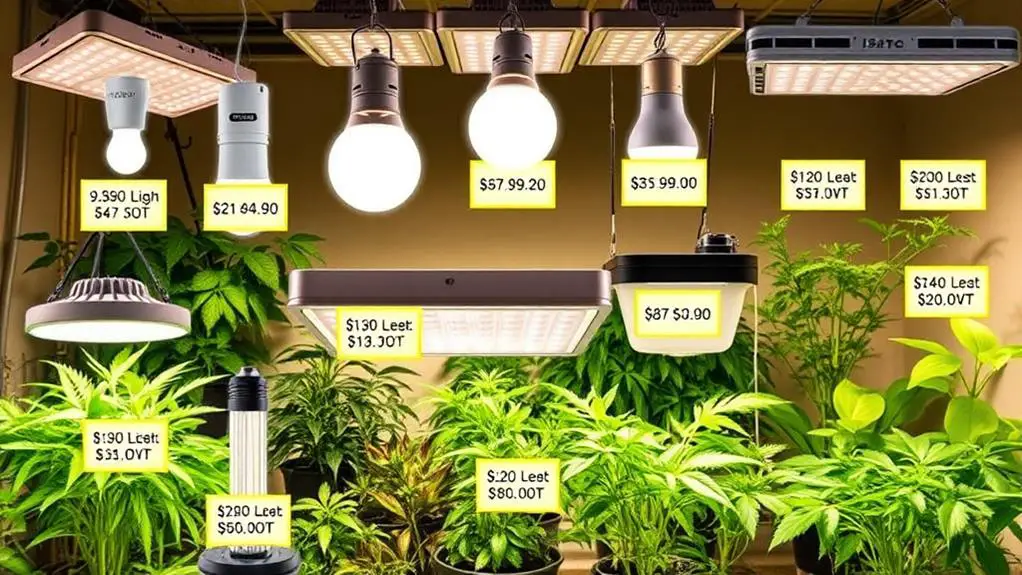
Choosing the right grow lights isn't just about the initial purchase—costs and accessories play a crucial role too. When deciding between fluorescent bulbs and LED grow lights, consider both the initial costs and long-term savings. Fluorescent bulbs are cheaper upfront, ranging from $7.99 to $30. However, LED grow lights, costing between $20 and $99, are more energy-efficient and last 3-5 times longer, making them a better investment over time.
Essential accessories, like timers and trays, also affect your budget. Timers guarantee your plants get consistent light, while trays catch spills. These accessories can range anywhere from $7.99 to $99.99. High-quality grow lights, combined with the right accessories, can enhance plant growth and reduce electricity costs.
Here's a quick comparison:
| Item | Price Range |
|---|---|
| Fluorescent Bulbs | $7.99 – $30 |
| LED Grow Lights | $20 – $99 |
| Timers | $7.99 – $99.99 |
| Trays | $7.99 – $99.99 |
| Lifespan (Hours) | 10,000 (Fluorescent) / 30,000-50,000 (LED) |
Local suppliers often offer quick access and satisfaction guarantees, making your shopping experience smoother. By carefully considering costs, energy efficiency, and the right accessories, you'll create an ideal environment for your plants to thrive.
Frequently Asked Questions
How to Choose the Proper Grow Light?
First, assess your plants' light needs, typically 12-18 hours daily. Choose full-spectrum grow lights with a 6500K CCT and CRI above 85. Opt for LEDs for longevity. Position lights correctly and use timers for effective light cycles.
What Wattage of Grow Light Do I Need?
You'll need to match grow light wattage to your plant's needs: 10-15 watts per square foot for low light, 15-20 for medium, and over 20 for high light. Remember, LED lights often outperform higher wattage fluorescent ones.
What Specs Should I Look for in a Grow Light?
Look for a grow light with a CCT of 6500K, a CRI above 85, full spectrum capabilities, and sufficient PPFD. Confirm adjustable height and adequate coverage for your growing area to avoid light stress or poor distribution.
What Type of Grow Light Is Best for Indoor Plants?
For indoor plants, choose LED grow lights. They're energy-efficient, long-lasting, and offer a full spectrum for all growth stages. Fluorescent lights work too, especially for low- to medium-light plants. Avoid incandescent lights due to inefficiency.
Conclusion
Choosing the right grow light doesn't have to be hard. Think about your plants' needs and the natural light in your space. Whether you go for LED, fluorescent, or incandescent, make sure it's full-spectrum for the best growth. Remember to check light specifications and place them correctly. With the right grow light, you'll see your plants thrive. Don't worry—you're on the right path to a beautiful indoor garden! Happy growing!



